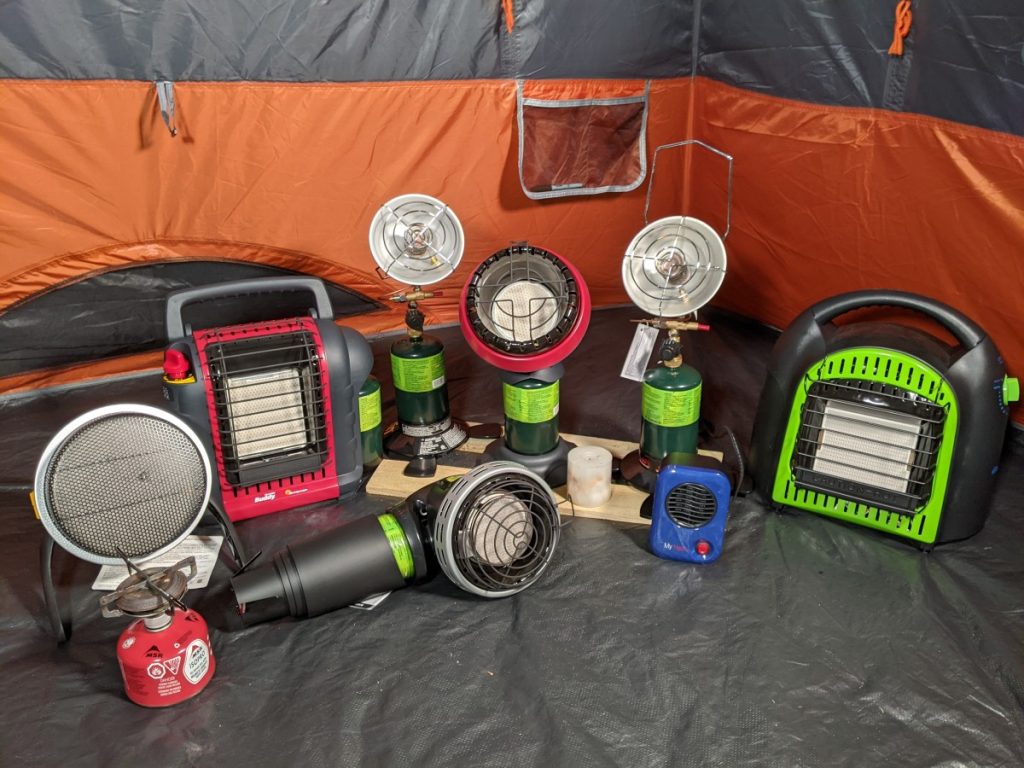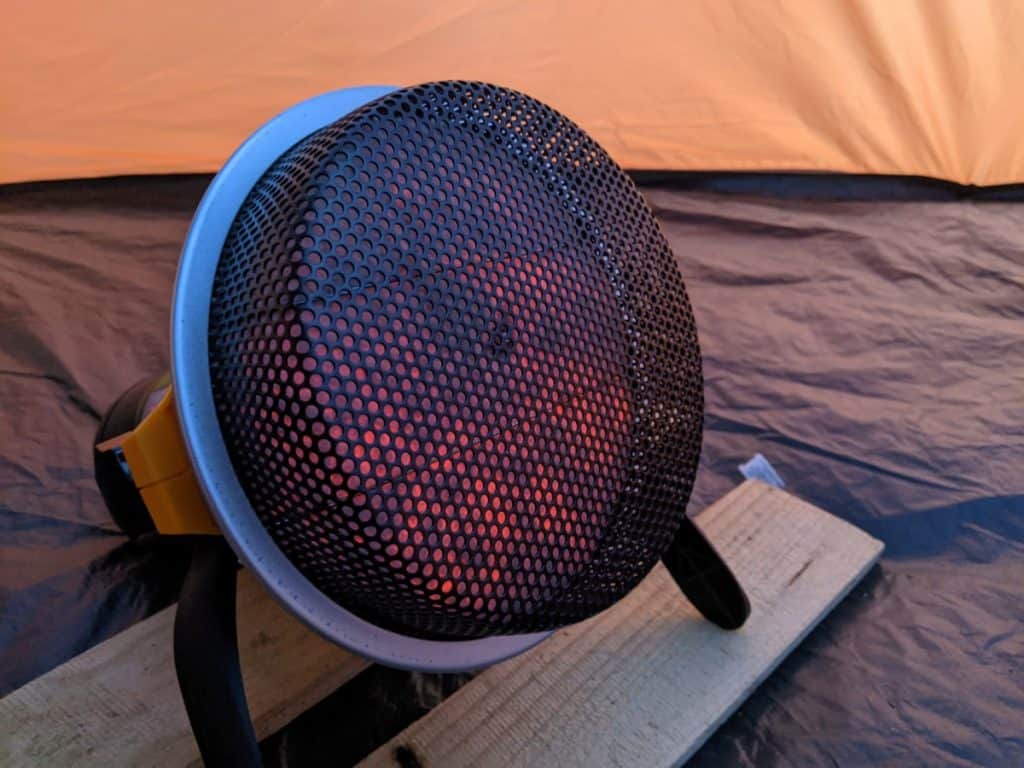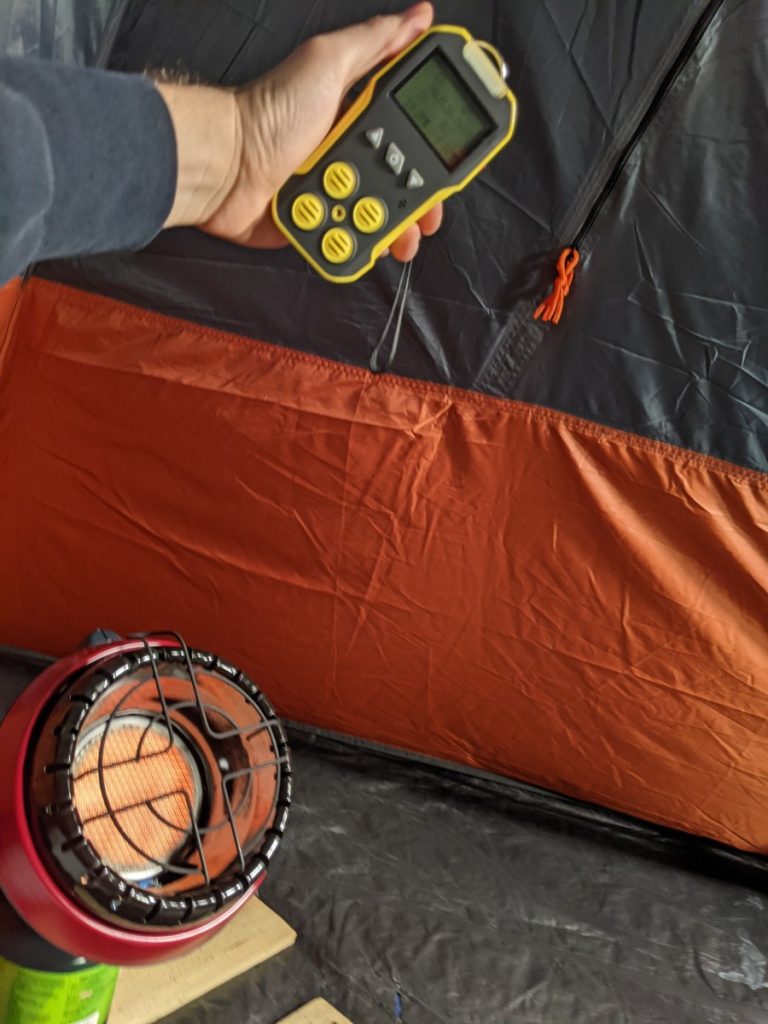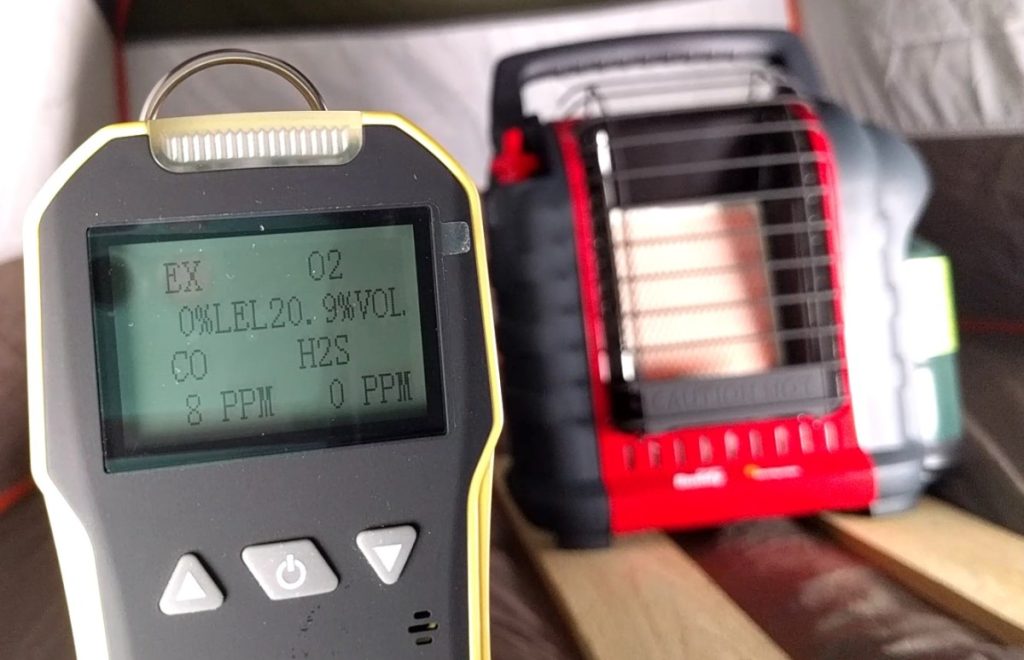I spent a ridiculous amount of time testing heaters in a tent.

Why would I do that? You might ask…
I’ve scoured several blogs about heaters in a tent and they recommended several of these heater models. I feel like that was unfair because many of these heaters are not rated for indoor use. I wondered what the difference between an indoor-rated heater and an outdoor-rated heater and if the infamous Mr. Heater Buddy line of heaters were actually safer.
If you want to see details about the tests in video form you can check it out on YouTube, here:
Let’s jump into the data. If you’re most interested in one aspect of the test, feel free to jump around using these:
Heaters I Tested
- Mr. Heater Portable Buddy
- Mr. Heater Little Buddy
- Mr. Heater Golf Cart
- Martin Radiant /Texport Radiant (same heater)
- Martin CH3 Catalytic
- Flame King CHS10
Safety Tests
I feel like I went overboard with the safety tests. You probably won’t find a more comprehensive set of safety tests done by an amateur as you’ll find here. I hope you enjoy them.
Tip Tests
I think this may arguably be the most important test–it turns out that the carbon monoxide output is an important factor, but if you have good ventilation it’s much less important than the notion that you have a very hot surface that you are bringing into an area with an extreme fire risk–your tent.
I simply tipped the heaters over to determine their safety features.
The Martin Radiant / Texport and the Martin CH3 did not have any tip detection advertised. As expected, they didn’t shut off when tipped.

The Martin CH3 however is in a tripod shape and is actually very sturdy and difficult to tip. Although it doesn’t have a tip detector I’d say it’s actually not a bad option. It’s still possible to knock over, though.
Data
| Heater | Tip Test |
|---|---|
| Martin Radiant / Texport | N/A (FAIL) |
| Martin CH3 | N/A (Pass?) |
| Mr. Heater Little Buddy | Pass |
| Mr. Heater Portable Buddy | Pass |
| Mr. Heater Golf Cart | FAIL |
| Flame King CHS10 | Pass |
The Golf Cart heater actually when laid down did not shut off the gas when tipped over. It supposedly has a less-sensitive tip detector because it’s meant to be driven around… but I did knock it down with enough force where I think it should have cut off. It really would have to fall down in order to cut off I think–or my unit was defective.
Gas Tests
I did a lot of gas tests and I’m not going to give you all the gory details of what I tried–but I’ll summarize.
I tested the heaters in normal ventilation and weaker ventilation conditions inside my big tent (9ft-Lx10ft-Wx6.5ft-H) and I tested some of the heaters inside the smaller tent with normal and weaker ventilation conditions.
The Flame King was not eligible for testing in the small tent because the gas control knob wouldn’t allow for it to be set to low–when I set it to “low” the gas would flutter and not burn correctly, letting off a lot of carbon monoxide. Either the unit was malfunctioning or this is a design flaw.
The pass/fail evaluation for these tests is a bit harder to make because all of these heaters are dangerous in a low-ventilation situation. All of the heaters seemed to perform okay in good ventilation
Also, I tested these heaters for carbon monoxide as I was lighting them and also right above the unit to see what kind of gas emissions were being dispersed into the tent:
Light Test
| Heater | Light Test (Carbon Monoxide PPM) |
|---|---|
| Martin Radiant / Texport | ~23PPM CO |
| Martin CH3 | ~10PPM CO |
| Mr. Heater Little Buddy | ~37PPM CO |
| Mr. Heater Portable Buddy | ~10PPM CO |
| Mr. Heater Golf Cart | ~30PPM CO |
| Flame King CHS10 | ~21PPM CO |
As I lit the heaters I measured the gas output–sure enough, all of the units output carbon monoxide during lighting. ~35 PPM CO is not a dangerous amount for just a few seconds, though. Several standards say that from 25-50PPM CO is dangerous when exposed for more than 8 hours.
~35PPM for a few seconds is not a big deal.
Near-Gas Test
I held up the detector right above the unit after it had been burning for a few minutes.

| Heater | Near-Gas Test (Carbon Monoxide PPM) |
|---|---|
| Martin Radiant / Texport | 0PPM CO |
| Martin CH3 | ~5PPM CO |
| Mr. Heater Little Buddy | ~15PPM CO |
| Mr. Heater Portable Buddy | ~5-6PPM CO |
| Mr. Heater Golf Cart | ~5-6PPM CO |
| Flame King CHS10 | ~5-6PPM CO |
None of these amounts are concerning–although it is of note that out of all these heaters that the Little Buddy put off the most CO.
In-Tent Gas Test
The near gas tests are interesting, but the most important question is does carbon monoxide build up in the tent with these propane heaters?
For the in-tent gas test I ran the heater for 15 minutes with good or bad ventilation in a big or small tent.
As I mentioned, previously, I couldn’t run the Flame King in the small tent because it would put off too much heat and could have damaged my tent if I put it on high. I couldn’t put the unit on low because it wasn’t working properly.
| Heater | Ventilation | Tent | In-Tent Gas Test (Carbon Monoxide PPM) |
|---|---|---|---|
| Flame King CHS10 | Good | Big | 0 PPM |
| Flame King CHS10 | Poor | Big | 11 PPM (FAIL) — NO GAS BUILDUP SHOULD HAPPEN |
| Flame King CHS10 | Good | Small | N/A (didn’t run the tests because heater could not run on low) |
| Flame King CHS10 | Poor | Small | N/A |
| Martin CH3 | Good | Big | 0 PPM |
| Martin CH3 | Poor | Big | 0 PPM |
| Martin CH3 | Good | Small | 0 PPM |
| Martin CH3 | Poor | Small | 0 PPM (Oxygen dropping .7-.8%) |
| Martin Radiant / Texport | Good | Big | 0 PPM |
| Martin Radiant / Texport | Poor | Big | 0 PPM |
| Martin Radiant / Texport | Good | Small | 0 PPM |
| Martin Radiant / Texport | Poor | Small | 0 PPM (Oxygen dropping .5%) |
| Mr. Heater Golf Cart | Good | Big | 0 PPM |
| Mr. Heater Golf Cart | Poor | Big | 0 PPM |
| Mr. Heater Golf Cart | Good | Small | 0 PPM |
| Mr. Heater Golf Cart | Poor | Small | 14 PPM, 20% oxygen (dropped 1%) |
| Mr. Heater Little Buddy | Good | Big | 0 PPM |
| Mr. Heater Little Buddy | Poor | Big | 0 PPM |
| Mr. Heater Little Buddy | Good | Small | 0 PPM (Trace amounts of CO) |
| Mr. Heater Little Buddy | Poor | Small | 14 PPM (Oxygen dropping .6%) |
| Mr. Heater Portable Buddy | Good | Big | 0 PPM |
| Mr. Heater Portable Buddy | Poor | Big | 0 PPM |
| Mr. Heater Portable Buddy | Good | Small | 8 PPM (Trace amounts of CO) |
| Mr. Heater Portable Buddy | Poor | Small | 21 PPM (Oxygen dropping .7%) |

That’s a lot of data… my takeaway was that all of these heaters did really well with carbon monoxide. The only one of real concern was the Flame King. The unit would start fluttering and the tiles would stop glowing as much and so it was half burning the propane which was putting off a fair amount of carbon monoxide.
These heaters can malfunction, even if they have lots of safety features–they are not to be used while sleeping or otherwise unattended.
It was also made very clear to me that these heaters are meant to be used with good ventilation. The small tent I actually partially covered up the roof vent and as you could see all of the heaters were slowly eating away at the oxygen in the tent and many of them were building up CO.

A low-ventilation scenario isn’t hard to do. In fact, all you have to do is not set up your tent all the way and you could be in a low O2 or high CO situation.
Always make sure you have plenty of ventilation before using any type of propane heater.
Also, I wouldn’t use a gas heater for a small tent. In my opinion there’s too much risk of tipping it over–and the units need 3ft of clearance on the sides and top.
Proximity Tests
Something you might not think about when getting these heaters is do they put the heat in the right places?
What you don’t want is for the heat to go downwards, melting your tent floor or igniting your blankets.
I considered these as passing if they didn’t get too hot 3ft above the unit and if they didn’t get the floor too warm
| Heater | Proximity Tests |
|---|---|
| Martin Radiant / Texport | PASS |
| Martin CH3 | PASS |
| Mr. Heater Little Buddy | PASS |
| Mr. Heater Portable Buddy | PASS |
| Mr. Heater Golf Cart | PASS |
| Flame King CHS10 | PASS (I felt like the floor was getting a bit too warm on the ground, but I don’t think it was dangerous) |
Blow-Out Detection
I tested if the units would cut themselves off if you blew out the flames.
| Heater | Blow-Out Detection (LEL) |
|---|---|
| Martin Radiant / Texport | 40 seconds |
| Martin CH3 | Couldn’t Blow Out |
| Mr. Heater Little Buddy | Flammable gasses got to ~6% above unit |
| Mr. Heater Portable Buddy | Flammable gasses got to ~10% above unit |
| Mr. Heater Golf Cart | Flammable gasses got to ~23% above unit |
| Flame King CHS10 | Flammable gasses got to ~12% above unit |
For the Martin Radiant and the Texport, I thought that they didn’t have a blow-out detection feature–doing more research I found that they did. After trying it outside I found it took 40 seconds for it to cut off. Believe me, that will fill your entire tent with propane smell and it will take a while for it to air out.
I’m not positive because I didn’t try to light a match, but I think that is too high and not safe for indoor use (which is fine, since it’s not rated for indoor use anyway).
Stability Tests
Besides the Tip test, one thing I noticed was that the different units had different stabilities. In my opinion, the heaters that use the propane cylinder as a stand were the least stable.
| Heater | Stability (least stable 1-10 most stable) |
|---|---|
| Martin Radiant / Texport | 5 |
| Martin CH3 | 10 |
| Mr. Heater Little Buddy | 3 |
| Mr. Heater Portable Buddy | 8 |
| Mr. Heater Golf Cart | 9/1 |
| Flame King CHS10 | 7 |
The Flame King and the Portable Buddy were pretty close, but side by side, the Portable Buddy felt more stable to me.

Debris Test
One crazy test I did was to actually try throwing some debris into the heaters to see how the heaters would perform.

The carbon monoxide shot up temporarily for all of them as the grass and dirt burned off for a minute or so.
The only winner of this category was the Golf Cart Heater. It was the only heater that actually has a mesh frame that kept out the grass from getting stuck on the heating element and burning up.
Temperature Tests
Besides safety, I wanted to see how well these heaters worked in a tent and which one was most effective.
This turned out to be a bit more tricky than the other tests. These heaters are radiant or catalytic heaters–which means they work by emitting directional heat in the form of infrared light (similar to a heat lamp).
Measuring the temperature of the air does not exactly tell the whole story. So, take these numbers with a grain of salt. I think my test method though does compare the heaters to each other. So, perhaps the actual temperatures are off, but you can see which heaters heat the best.
My compromise was that I used two thermometers, one that was 3 ft from the heater where the heat should be, and another thermometer 3 ft away off center from the heater.

Next, I did a race–the first thermometer to go up 5 degrees (from 53F to 58F) won. The temperature was about the same from 47F to 49F outside the tent.
| Heater | Time to Increase By 5 Degrees Fahrenheit (Lower is Better) | Temperature After 15 Minutes Starting timer at 53F (Higher Is Better) |
|---|---|---|
| Martin Radiant / Texport | 00:08:01 | 60.4F |
| Martin CH3 | 00:07:00 | 61.3F |
| Mr. Heater Little Buddy | 00:12:12 | 58.1F |
| Mr. Heater Portable Buddy | 00:3:20 | 65.7F |
| Mr. Heater Golf Cart | 00:11:20 | 58.6F |
| Flame King CHS10 | 00:02:10 | 68.4F |
All in all the Flame King dominated the temperature tests–rasiging the temperature the most and the fastest. The Portable Buddy was right behind, while the Little Buddy lagged at the end but did comparably with the Golf Cart Heater.
Efficiency Tests
Lastly, I wanted to see how long these heaters lasted. I admit, these are my weakest tests because I didn’t start them all off on a new tank of gas–I was lazy and they all used one tank throughout all the tests.
However, I think there’s still some valuable data and you can get a pretty good idea of how long they will last. All of this is for heaters burning through a single 1lb propane tank.
| Heater | Time On High | Time On Low |
|---|---|---|
| Martin Radiant / Texport | 04:34:00 | 00:30:00 |
| Martin CH3 | 05:28:00 | 00:36:00 |
| Mr. Heater Little Buddy | 04:54:00 | N/A (No low setting) |
| Mr. Heater Portable Buddy | 01:51:00 | 00:40:00 |
| Mr. Heater Golf Cart | 05:08:00 | N/A (No Low Setting) |
| Flame King CHS10 | 01:49:00 | N/A (Low Setting Didn’t Work) |
The Martin CH3 advertises that it lasts 7 hours on low and I believe it–on high it lasted about 5 and a half hours.
The Portable Buddy was actually much more efficient than the Flame King although it doesn’t put quite the same amount of heat out–however, the heat difference vs. the time difference is striking and the Portable Buddy to me did much better as far as efficiency goes.
Conclusion
In my opinion, the Portable Buddy (got mine on Amazon) is the best option and is the only one of these that I decided to keep. The others are fine pieces of equipment, but I like the flexibility of the Portable Buddy over the Little Buddy. The Portable Buddy can burn on high and on low and is more stable.
I talk more about the best three out of this lineup and which ones I would recommend buying in my article, here.

